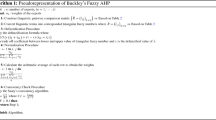Abstract
The traditional failure mode and effect analysis (FMEA) aims to define the risk priority number of each failure mode by multiplying occurrence, severity and detection parameters of each failure mode. Many studies in the literature commented the traditional FMEA due to its limitations such as equal importance degrees, discrete ordinal scales and multiplication of O, S and D criteria. This study suggests coping with these drawbacks a new method, which combines the quality function deployment (QFD) method under interval type-2 fuzzy set, Bayesian network and VIKOR method. The previous studies generally handle to rank the failure modes as only goal. This paper investigates concurrently the failure modes and the reasons of failure modes. QFD method provides us this benefit by employing customer requirements (CRs) and design requirements (DRs). CRs are the reasons of failure modes while DRs are failure modes. This study presents a new perspective to examine the correlations of CRs and DRs as linguistic terms by using Bayesian network. The VIKOR method deals with ranking the failure modes by aggregating the weights of O, S and D criteria. The developed method is utilized for risk evaluation of tile and marble works in building construction. The result shows that the most significant design requirement or failure mode is DR14 (unsuitable plug-socket utilization).






Similar content being viewed by others
References
Akao Y (1990) Quality function deployment: integrating customer requirements into product design. Taylor & Francis, Karnataka
Cao X, Deng Y (2019) A new geometric mean FMEA method based on information quality. IEEE Access 7:95547–95554
Chen L, Deng Y (2018) A new failure mode and effects analysis model using Dempster-Shafer evidence theory and grey relational projection method. Eng Appl Artif Intell 76:13–20
Chen LH, Chen CN (2014) Normalisation models for prioritising design requirements for quality function deployment processes. Int J Prod Res 52(2):299–313
Efe B (2019) Analysis of operational safety risks in shipbuilding using failure mode and effect analysis approach. Ocean Eng 187:106214
Efe, B. (2019b). Website evaluation using interval type-2 fuzzy-number-based TOPSIS approach. In: Multi-criteria decision-making models for website evaluation (pp. 166–185). IGI Global, Pennsylvania
Efe B, Kurt M, Efe ÖF (2017) An integrated intuitionistic fuzzy set and mathematical programming approach for an occupational health and safety policy. Gazi Univ J Sci 30(2):73–95
Efe B, Yerlikaya MA, Efe ÖF (2016) İş güvenliğinde bulanik promethee yöntemiyle hata türleri ve etkilerinin analizi: bir inşaat firmasinda uygulama. Gümüşhane Üniv Fen Bilim Enst Derg 6(2):126–137
Ghoushchi SJ, Yousefi S, Khazaeili M (2019) An extended FMEA approach based on the Z-MOORA and fuzzy BWM for prioritization of failures. Appl Soft Comput 81:105505
İlbeyi AS (2019) Derin kazı ve zemin iyileştirme yapılan inşaat sahalarında risk değerlendirmesi. Çanakkale onsekiz mart üniversitesi fen bilimleri enstitüsü yüksek lisans tezi
Jiang W, Xie C, Zhuang M, Tang Y (2017) Failure mode and effects analysis based on a novel fuzzy evidential method. Appl Soft Comput 57:672–683
Lee LW, Chen SM (2008) Fuzzy multiple attributes group decision-making based on the extension of TOPSIS method and interval type-2 fuzzy sets. In: Proceedings of the 2008 international conference on machine learning and cybernetic. Kunming, China, pp. 3260–3265
Li YL, Wang R, Chin KS (2019) New failure mode and effect analysis approach considering consensus under interval-valued intuitionistic fuzzy environment. Soft Comput 23(22):11611–11626
Liu B, Deng Y (2019) Risk evaluation in failure mode and effects analysis based on D numbers theory. Int J Comput Commun Control 14(5):672–691
Liu HC, Wang LE, You XY, Wu SM (2019) Failure mode and effect analysis with extended grey relational analysis method in cloud setting. Total Qual Manag Business Excell 30(7–8):745–767
Liu HC, You JX, Duan CY (2019) An integrated approach for failure mode and effect analysis under interval-valued intuitionistic fuzzy environment. Int J Prod Econ 207:163–172
Pearl J (1998) Graphs, causality, and structural equation models. Sociol Methods Res 27(2):226–284
Polat B, Polat A (2017) İnşaat sektöründe doğu anadolu bölgesi için iş güvenliği koşullarinin incelenmesi. Int J Pure Appl Sci 3(1):24–32
Qin J, Xi Y, Pedrycz W (2020) Failure mode and effects analysis (FMEA) for risk assessment based on interval type-2 fuzzy evidential reasoning method. Appl Soft Comput 89:106134
Wang Z, Ran Y, Chen Y, Yu H, Zhang G (2020) Failure mode and effects analysis using extended matter-element model and AHP. Comput Ind Eng 140:106233
Zhou Q, Thai VV (2016) Fuzzy and grey theories in failure mode and effect analysis for tanker equipment failure prediction. Saf Sci 83:74–79
Zhu J, Shuai B, Li G, Chin KS, Wang R (2020) Failure mode and effect analysis using regret theory and PROMETHEE under linguistic neutrosophic context. J Loss Prev Process Ind 64:104048
Author information
Authors and Affiliations
Corresponding author
Ethics declarations
Conflicts of interest
The authors do not have any conflicts.
Additional information
Publisher's Note
Springer Nature remains neutral with regard to jurisdictional claims in published maps and institutional affiliations.
Rights and permissions
About this article
Cite this article
Efe, B., Efe, Ö.F. Quality function deployment based failure mode and effect analysis approach for risk evaluation. Neural Comput & Applic 33, 10159–10174 (2021). https://doi.org/10.1007/s00521-021-05778-1
Received:
Accepted:
Published:
Issue Date:
DOI: https://doi.org/10.1007/s00521-021-05778-1




